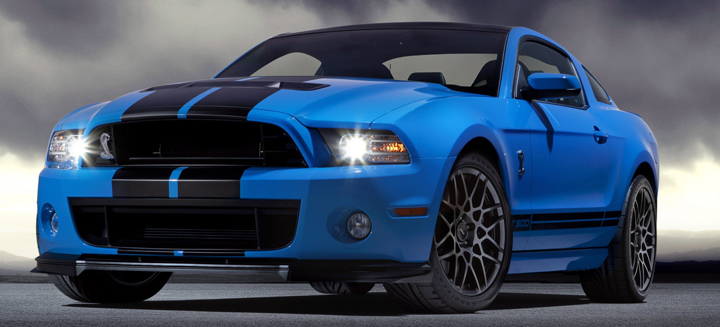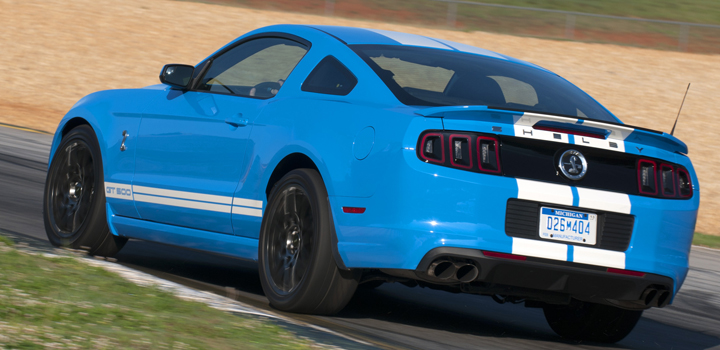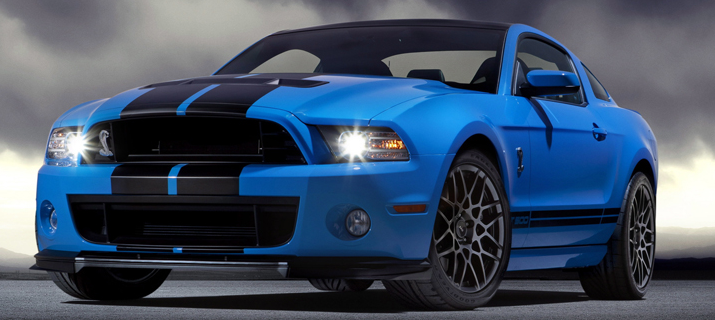
Test car came equipped with: SVT performance package, SVT Track Package, Electronics Package with navigation system, Recaro-brand seats with leather upholstery. Total MSRP with $795 destination = $65,420.
First Spin: 2016 Ford Shelby GT350 and GT350R Mustang
Powertrain: 5.8-liter, 662-horsepower supercharged V8, 6-speed manual transmission, rear-wheel drive.
Acceleration: Despite its many changes—including “bumps” of no less than 112 horsepower and 121 pound-feet of torque—the 2013 GT500 feels little faster in routine driving than the 2012 version. That’s because the power hikes and other changes were made mostly in pursuit of a claimed 200-mph top speed and more-precise track handling. Motor Trend and Car and Driver both report 0-60 mph at 3.5 seconds—believable, and I think a smidge better than before—and quarter-mile times that would have seemed unbelievable just five years ago. MT, for example, timed 11.6 seconds at 125.7 mph. If “11” were on our acceleration rating scale, this car would earn it. The latest GT500 is not only the most potent production Mustang ever, it’s the most powerful car you can buy for under $100,000, at least for now.
Though 662 horsepower might seem frightening, the GT500 is about as easy to drive as it ever was. Clean, no-wheelspin first-gear standing-starts are available even without using the included Launch Control feature, abetted by clutch action that’s smooth and progressive, if close to Thighmaster stiff. And the engine has so much torque that it easily tolerates takeoffs in second gear, a good way to avoid scaring yourself, especially in wet weather. Floor the throttle in first, however, and you’ll be pinned to the seat, accompanied by a fair bit of tire squeal—even with the traction control deploys—and on some surfaces a bit of tail slithering. Alas, the 6-speed manual transmission compromises overall performance and driving ease—or did for us—with very heavy, very notchy shift action that quickly grows tiring and tiresome in city/suburban traffic.
For both top speed and fuel economy, the ’13 GT 500 combines a fairly “long” 3.31:1 rear-axle ratio with two overdrive transmission gears, a 0.77:1 fifth and a rangy 0.50:1 sixth. As a result, the car simply loafs at typical highway speeds, the tachometer showing well under 2000 rpm at 70 mph in fifth and sixth gear. Yet there’s good surge available in fifth from that speed, reflecting bountiful low-end torque, and the car will happily potter around the suburbs in sixth at 40-50 mph. With all this, we can easily believe the near-200-mph top speeds recorded by both MT and C/D.
More Shelby-related news and reviews

Fuel Economy: We averaged 17.8 mpg in Phoenix-area driving split roughly 55/45 city/freeway. That’s surprisingly decent considering the fierce acceleration, and it aligns well with EPA estimates of 15 city, 24 highway, and 18 combined. Of course, premium-grade fuel is mandatory.
Ride Quality: The test car came on high-performance Goodyear Eagle F1 Supercar tires in staggered sizes: P265/40ZR19-98Y front, P285/35ZR20-92Y rear. Those stiff, narrow-sidewall boots combine with super-tight springs and shocks for a buckboard-bouncy ride except on the smoothest of surfaces. There’s little “comfort” here, so I’d rate this car a “2.” Though the ride isn’t terrible for a muscle machine and the solid rear axle is generally well behaved on rough patches, all but diehard enthusiast drivers will find themselves constantly looking for the smoothest pavement. The test car’s optional SVT Performance Package includes two-mode driver-adjustable shock absorbers, but we couldn’t tell much difference between the settings.
Steering/handling/braking: No surprise here. The Shelby deserves a solid “10.” As before, the GT500 blasts around corners with good balance and grip, provided you’re cautious with the gas pedal, especially on damp roads. Powering-on at the wrong moment almost guarantees a lurid tail slide, again even with the stability/traction system online. The difference between last year and this year is that everything happens rather faster in the buffed-up 2013. Body lean remains near nil, as you’d jolly well hope in view of the rocky ride. All Mustangs now have three-mode “selectable steering,” but it’s another of those gimmicks that makes little practical difference no matter how it’s set. In the Shelby, Sport mode does increase steering effort enough to be noticeable—and tedious at times. Standard and Comfort modes felt about the same to us, and none of the settings improves the rather disconnected steering feel. The test car also wandered some along longitudinal grooves and ridges, which only highlighted the numb helm response. Braking, on the other hand, is superb. The Shelby’s big Brembo-brand discs erase speed quickly with no drama and surprisingly manageable pedal effort.
Shelby American Makes Its Mark on the Ford SVT Raptor
Quietness: High-performance cars aren’t supposed to be quiet, but this one is noisier than most and worth only a “2” in my book. Enthusiasts will love the menacing low-rpm exhaust rumble and the engine’s deep-chested high-rpm roar, but mechanical noise is always quite high. The same goes for tire drone. In fact, the Shelby made so much ruckus in regular driving that we didn’t even bother listening to the high-power stereo, which would have needed turning up to ear-splitting levels anyway. There’s some highway wind noise, too, though it’s hard to detect with everything else going on.
Controls: As the main report notes, the Shelby’s optional SVT Performance Package features a specific instrument cluster. This includes a speedometer calibrated to—gulp!—220 mph, plus a multi-function display between the speedo and tachometer that’s controlled by a switch pad on the left steering-wheel spoke. Annoyingly, the pad doesn’t quite fit the spoke and is thus finicky to manipulate. Too bad, because this control can do many things. For example, it can access “Track Apps” functions—traction off, launch control, steering, and shock settings—which are curiously duplicated by “hard” switches on the dashboard. The pad can also summon up trip data and a bevy of real-time engine info: air/fuel ratio, boost pressure/vacuum level, intake-air temperature, oil pressure, oil temperature, and voltage. It’s all quite apropos for a power-mad enthusiast’s car, but it’s more than some people might want to deal with. Otherwise, the Shelby has the same basic controls and layout as other Mustangs. I’d rate it a “7” here, mainly for the super-complete instrumentation.
Details: Aside from the above-mentioned gauge cluster, plus a cue-ball shift knob and a steering wheel partly rimmed in synthetic suede, the GT500 matches mainstream Mustangs for interior materials, workmanship, and atmosphere. That means high-grade soft-touch surfaces and nice-looking metallic trim contrasting with hard plastic panels and flimsy-feel bits like the seat-height and backrest levers. However, the test car’s cabin got a welcome lift from the optional Recaro-brand seats with their attractive, handsomely stitched two-tone leather upholstery.
Room/comfort (front): Here, too, the Shelby shares pluses and minuses with other Mustangs. Negatives include a poorly designed lidded console box that my shift elbow inevitably and painfully collides with. I’ve hated it ever since Mustang’s 2010 overhaul. Too bad Ford won’t change it now, what with the all-new 2015s on the horizon. I liked the tester’s optional Recaro-brand seats, although the huggy side bolsters are bulky enough to impede entry/exit a little. The lack of power seat adjustments is disappointing in a $65,000 car. So, too, are the lack of a telescopic steering wheel and height-adjustable shoulder-belt anchors. Rear visibility in any Mustang coupe is miserable unless the absurdly tall rear headrests are flopped down, which is fairly easy to do from outside the car—if you’re sufficiently limber and long-of-limb.
Room/comfort (rear): Mustang’s rear seat has always been mainly for show—and to qualify for lower insurance rates than most two-seat cars would. It’s really just for “emergencies.”
Cargo room: As the main report states, Mustang coupes have a usefully large trunk that’s not always easy to load. And I agree that cabin storage is sparse. Has been for ages.
CP Says . . . The main report nicely sums up the Mustangs most people buy. But the Shelby versions have always been barely tamed beasts for an understanding few, and the 2013 GT 500 is the wildest yet.
There are two ways to look at it, I think. First, even at $54,200 minimum, it is undeniably a tremendous performance bargain, offering supercar power, speed, and thrills for hundreds of thousands less than a comparable exotic such as Ferrari’s new front-engine F12 or the mid-engine Lamborghini Aventador. In fact, with an officially certified 662 horses, this “lowly” Ford is just 38 shy of the new 700-horse Lambo that costs $376,000! What’s more, the 2013 GT500 is faster and more potent than Ford’s own mid-engine GT supercar of a decade ago—no surprise, as the Shelby builds on that car’s technology, especially the engine. Then too, this ultimate production ’Stang seems extra special now that the great Carroll Shelby has left us after giving his personal blessing to this one last namesake car.
On the other hand, the 2013 GT500 is arguably the most excessive Shelby Mustang ever. Some will consider this a good thing, but I don’t. Unless you’re a racer or own your racetrack, what good is 662 horsepower—or last year’s 550, for that matter—except for impressing friends and maybe winning the occasional stoplight drag race? For me, the GT500 is not a Mustang as I’ve known it. It’s a post-modern muscle car that looks like a Mustang but acts like a crazed stallion and is far less pleasant and practical with it. Yes, it has been made to handle well, especially on the track, and it could be your daily driver, only it has the same drawbacks as any other Mustang. And it’s so much noisier!
So what price do we pay for prodigious power, a 200-mph top-speed potential, and the legendary Shelby name? In this case, it’s nearly $20,000 base versus the 5.0-liter V8 GT coupe, which is obviously more my kinda car and a far better bet. But even I can be thankful that Ford keeps putting money into the GT500. Our automotive world would be a lot poorer without it.
Photo Feature: 1970 Shelby GT-500 Fastback



